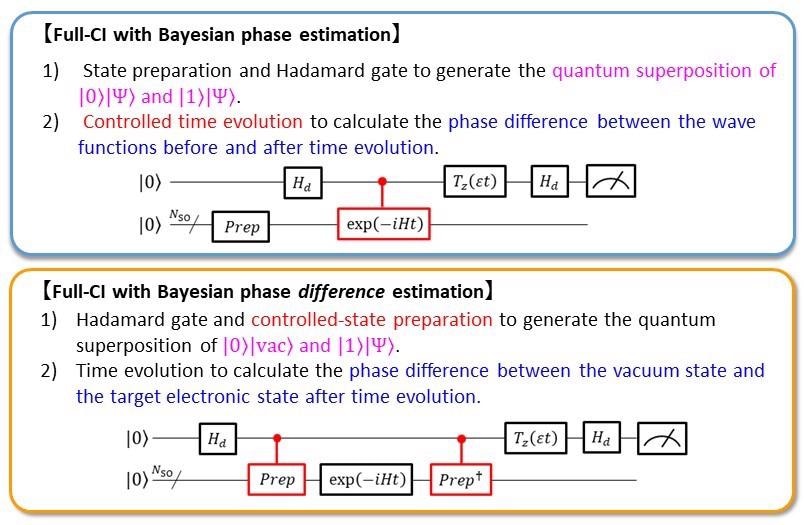A group of scientists from the Graduate School of Science at Osaka Metropolitan University continues to enhance their newly formulated quantum algorithm, this time by using it to quantify the potential energy curves of the H2 molecule without the requirement for controlled time evolutions.

Image Credit: Graduate School of Science, Osaka Metropolitan University.
By incorporating a controlled-state preparatory step to the Bayesian phase difference estimation (BPDE) quantum algorithm they earlier formulated, the scientists measured the superposition of the “vacuum” wave function with zero electrons and the wave function of the preferred electronic state, surpassing the need to mimic the time evolution of the wave function subject to an ancillary qubit.
This resolves a problem typical to conventional quantum algorithms, that is the parallel processing of quantum gates and a large number of quantum gates between two non-adjacent qubits — showing itself as a quantum algorithm workable on quantum computers that can conduct full configuration interaction (full-CI) calculations of molecules and atoms.
It is important to see that the full-CI calculations can offer the enhanced solutions of Schrödinger equations for microscopic systems, but not intractable for the sizable systems with classical computers due to the exponential explosion of required computing time.
Their study was published as an open-access article in The Journal of Physical Chemistry Letters.
In the race to precisely unravel the Schrödinger equation to demonstrate the electronic state of a molecule or atom and cause a paradigm shift in scientific exploration and materials development, researchers have sought quantum computers to perform chemical calculations in polynomial time.
The quantum phase estimation (QPE) algorithm has evolved into a well-established and strong tool in providing full-CI calculations of wave functions for small molecules, and numerous attempts have been carried out to have QPE-based techniques account for the computational costs that exponentially add up against the system size in question.
QPE-based methods simulate the time evolution of a wave function on an ancillary qubit, which requires many controlled quantum gates, the presence of which also hinders parallel execution of these gates and compression of quantum circuits.
Kenji Sugisaki, Study Lead Author and Specially-Appointed Lecturer, Graduate School of Science, Osaka Metropolitan University
“In this research, we have applied our Bayesian phase difference estimation (BPDE) algorithm, which is a modification of QPE and capable of bypassing the need of controlled time evolution operations, to perform full-CI calculations. We emphasize that our approach invokes the energy calculation of many-electron systems as referring to the counterpart of many-electron ionized systems,” Kenji Sugisaki added.
Evolving the wave function only when the first qubit is in the |1⟩ state makes it difficult to parallelize the quantum gates. Rewriting the quantum logic circuit so that the time evolution operator can be applied regardless of whether the first qubit is in the |0⟩ or |1⟩ state would allow easy parallel processing of quantum gates and increase the likelihood of implementing the algorithm in actual quantum computers.
Professor Kazunobu Sato, Research Advisor, Graduate School of Science, Osaka Metropolitan University
To achieve this, the researchers incorporated a controlled-state preparation that builds the quantum superposition of the “vacuum” wave function |vac⟩ with zero electrons and the wave function |Ψ⟩ of the target electronic state — “in other words, we computed the full-CI energy of an atom or molecule as its ionization energy,” explains Professor Emeritus Takeji Takui — with the ensuing logic circuit (|0⟩|vac⟩+|1⟩|Ψ⟩)⁄√2.
The team demonstrated the efficiency of their BPDE-based full-CI technique by measuring the possible energy curves of four valence electronic states of the H2 molecule.
The numerical simulations revealed that the BPDE-based method reproduces the full-CI energy within 3 kcal mol-1 of errors for all the electronic states.
Takeji Takui, Study Advisor and Professor Emeritus, Graduate School of Science, Osaka Metropolitan University
Significantly, being free from controlled time evolution renders parallelization of quantum gates and execution on real quantum devices easier, thus giving the researchers hope that their Bayesian phase difference estimation algorithm opens the door to more beneficial full-CI calculations and becomes equal to precise quantum chemistry.
Journal Reference:
Sugisaki, K., et al. (2021) Quantum Algorithm for Full Configuration Interaction Calculations without Controlled Time Evolutions. The Journal of Physical Chemistry Letters. doi.org/10.1021/acs.jpclett.1c03214.